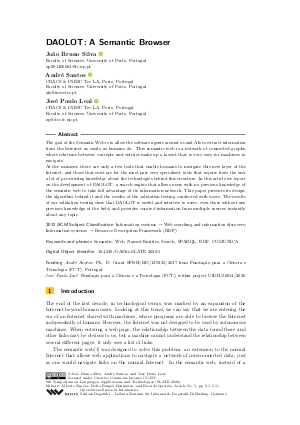DAOLOT: A Semantic Browser
Authors
João Bruno Silva  ,
André Santos
,
André Santos  ,
José Paulo Leal
,
José Paulo Leal 
-
Part of:
Volume:
9th Symposium on Languages, Applications and Technologies (SLATE 2020)
Part of: Series: Open Access Series in Informatics (OASIcs)
Part of: Conference: Symposium on Languages, Applications and Technologies (SLATE) - License:
 Creative Commons Attribution 3.0 Unported license
Creative Commons Attribution 3.0 Unported license
- Publication Date: 2020-09-16
File

PDF
OASIcs.SLATE.2020.5.pdf
- Filesize: 1.11 MB
- 11 pages
Document Identifiers
Subject Classification
ACM Subject Classification
- Information systems → Web searching and information discovery
- Information systems → Resource Description Framework (RDF)
Keywords
- Semantic
- Web
- Named Entities
- Search
- SPARQL
- RDF
- COMUNICA
Metrics
- Access Statistics
-
Total Accesses (updated on a weekly basis)
0PDF Downloads0Metadata Views
Abstract
The goal of the Semantic Web is to allow the software agents around us and AIs to extract information from the Internet as easily as humans do. This semantic web is a network of connected graphs, where relations between concepts and entities make up a layout that is very easy for machines to navigate. At the moment, there are only a few tools that enable humans to navigate this new layer of the Internet, and those that exist are for the most part very specialized tools that require from the user a lot of pre-existing knowledge about the technologies behind this structure. In this article we report on the development of DAOLOT, a search engine that allows users with no previous knowledge of the semantic web to take full advantage of its information network. This paper presents its design, the algorithm behind it and the results of the validation testing conducted with users. The results of our validation testing show that DAOLOT is useful and intuitive to users, even those without any previous knowledge of the field, and provides curated information from multiple sources instantly about any topic.
Cite As Get BibTex
João Bruno Silva, André Santos, and José Paulo Leal. DAOLOT: A Semantic Browser. In 9th Symposium on Languages, Applications and Technologies (SLATE 2020). Open Access Series in Informatics (OASIcs), Volume 83, pp. 5:1-5:11, Schloss Dagstuhl – Leibniz-Zentrum für Informatik (2020)
https://doi.org/10.4230/OASIcs.SLATE.2020.5
BibTex
@InProceedings{silva_et_al:OASIcs.SLATE.2020.5,
author = {Silva, Jo\~{a}o Bruno and Santos, Andr\'{e} and Leal, Jos\'{e} Paulo},
title = {{DAOLOT: A Semantic Browser}},
booktitle = {9th Symposium on Languages, Applications and Technologies (SLATE 2020)},
pages = {5:1--5:11},
series = {Open Access Series in Informatics (OASIcs)},
ISBN = {978-3-95977-165-8},
ISSN = {2190-6807},
year = {2020},
volume = {83},
editor = {Sim\~{o}es, Alberto and Henriques, Pedro Rangel and Queir\'{o}s, Ricardo},
publisher = {Schloss Dagstuhl -- Leibniz-Zentrum f{\"u}r Informatik},
address = {Dagstuhl, Germany},
URL = {https://drops.dagstuhl.de/entities/document/10.4230/OASIcs.SLATE.2020.5},
URN = {urn:nbn:de:0030-drops-130188},
doi = {10.4230/OASIcs.SLATE.2020.5},
annote = {Keywords: Semantic, Web, Named Entities, Search, SPARQL, RDF, COMUNICA}
}
Author Details
- CRACS & INESC Tec LA, Porto, Portugal
- Faculty of Sciences, University of Porto, Portugal
Funding
- Santos, André: Ph. D. Grant SFRH/BD/129225/2017 from Fundação para a Ciência e Tecnologia (FCT), Portugal.
- Leal, José Paulo: Fundação para a Ciência e a Tecnologia (FCT), within project UIDB/50014/2020.
References
-
Tim Berners-Lee, James Hendler, and Ora Lassila. The semantic web. Scientific american, 284(5):34-43, 2001.

-
Dan Brickley, Ramanathan V Guha, and Andrew Layman. Resource description framework (RDF) schema specification. Technical report, World Wide Web Consortium (W3C), 1999.

- Kendall Grant Clark, Lee Feigenbaum, and Elias Torres. SPARQL Protocol for RDF. W3c recommendation, W3C, January 2008. URL: http://www.w3.org/TR/rdf-sparql-protocol/.
- W3C Owl Working Group et al. Owl 2 web ontology language document overview, 2009. URL: http://www.w3.org/TR/owl2-overview/.
-
Sébastien Harispe, Sylvie Ranwez, Stefan Janaqi, and Jacky Montmain. Semantic measures for the comparison of units of language, concepts or entities from text and knowledge base analysis, October 2013.

-
C. Harris, A. Owens, A. Russell, and D. A. Smith. mSpace: Exploring the semantic web. a technical report in support of the mspace software framework. Master’s thesis, Faculty of Engineering, Science and Mathematics, University of Southhampton, 2004.

-
Michiel Hildebrand, Jacco Van Ossenbruggen, and Lynda Hardman. /facet: A browser for heterogeneous semantic web repositories. In International Semantic Web Conference, pages 272-285. Springer, 2006.

-
Ora Lassila, Ralph R Swick, et al. Resource description framework (RDF) model and syntax specification. Technical report, World Wide Web Consortium (W3C), 1998.

- Eric Prud'hommeaux and Andy Seaborne. SPARQL Query Language for RDF. W3C Recommendation, January 2008. URL: http://www.w3.org/TR/rdf-sparql-query/.
-
MC Schraefel, Daniel A Smith, Alisdair Owens, Alistair Russell, Craig Harris, and Max Wilson. The evolving mspace platform: leveraging the semantic web on the trail of the memex. In Proceedings of the sixteenth ACM conference on Hypertext and hypermedia, pages 174-183, 2005.

-
Ruben Taelman, Joachim Van Herwegen, Miel Vander Sande, and Ruben Verborgh. Comunica: a modular sparql query engine for the web. In International Semantic Web Conference, pages 239-255. Springer, 2018.

-
Carl W Turner, James R Lewis, and Jakob Nielsen. Determining usability test sample size. International encyclopedia of ergonomics and human factors, 3(2):3084-3088, 2006.

-
Ruben Verborgh, Miel Vander Sande, Olaf Hartig, Joachim Van Herwegen, Laurens De Vocht, Ben De Meester, Gerald Haesendonck, and Pieter Colpaert. Triple pattern fragments: a low-cost knowledge graph interface for the web. Journal of Web Semantics, 37:184-206, 2016.

